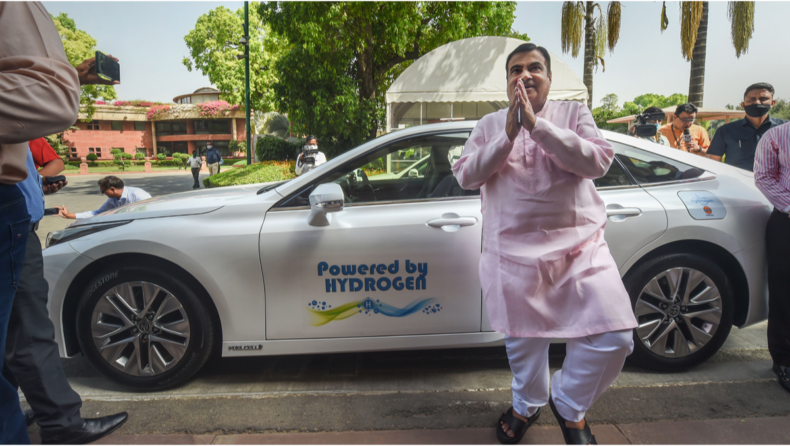Union transport minister Nitin Gadkari on Wednesday traveled to the parliament house in a hydrogen-based Fuel Cell Electric Vehicle (FCEV) and has already been intercepted by many as a strong indication of a shift in stance by the center that has so far backed conventional battery-powered electric vehicles or BEVs.
The special vehicle
Union Minister for Transport and Highways traveled in a Toyota Mirai, which houses 3 hydrogen tanks and can be refueled in an estimated five minutes.
Toyota Mirai is powered by a 182 hp electric motor housing a 1.24kWh Lithium-ion battery pack.
Car is powered by hydrogen or “Green Hydrogen” to be specific and is a very bold demonstration that emphasized the need to spread awareness about Hydrogen fuel cell vehicle technology and its benefits to support India’s ambitious energy transition and goal of net carbon neutrality by 2070.
Earlier this year, Union Minister Nitin Gadkari said in Goa that he would start using a vehicle that runs on green hydrogen as a pilot project and adding strength to his commitments Indian Oil Corporation (IOCL) has assured the continued supply of green hydrogen.
How is it different from conventional cars?
Electric Vehicles (EV) are divided into 4 broad categories which are
- BEV or Battery Electric Vehicle.
- HEV or Hybrid Electric Vehicle.
- PHEV or Plug-in Hybrid Electric Vehicle.
- FCEV or Fuel Cell Electric Vehicle.
-

Image credits: -e-AMRIT, Niti Aayog 
Image credits: -e-AMRIT, Niti Aayog 
Image credits: -e-AMRIT, Niti Aayog 
Image credits: -e-AMRIT, Niti Aayog FCEVs combine hydrogen and oxygen to produce electricity which runs the motor and a few examples of such types are Mirai by Toyota, Clarity by Honda, and Nexo by Hyundai uses hydrogen gas to power an onboard electric motor.
As they’re powered entirely by the electricity generated by their engine, FCEVs are considered electric but unlike BEVs their range and refueling processes are comparable to conventional cars and trucks.
Benefits to the consumer are huge as they get five times better energy storage per unit volume and weight which frees up a lot of space for other things allowing the rider to go further.
How FCEVs work and Hydrogen
A fuel cell converts chemical energy into electrical energy using oxidizing agents through an oxidation-reduction reaction.
Hydrogen is the most common element in nature is not found freely, Hydrogen exists only in a combined form with other elements and has to be extracted from naturally occurring compounds like water (Consisting of 2 Hydrogen atoms and 1 Oxygen atom). Although hydrogen is a clean molecule the process of extracting it is energy-intensive.
Hydrogen produced from fossil fuels is called “grey hydrogen” which constitutes the bulk of the hydrogen produced today.
Hydrogen generated from fossil fuels with carbon capture and storage options is called “blue hydrogen”.
Hydrogen generated entirely from renewable power sources is called “green hydrogen”.
As for EVs, we need charging stations similarly for Hydrogen-powered vehicles we need refueling stations which have increased from 330 in 2017 to 540 in 2020 worldwide.
Hydrogen is an energy carrier not a source of energy and hydrogen fuel must be transformed into electricity by a device called a fuel cell stack before it can be used to power a car or truck.

Image Credits: – Alternative Fuels Data Center- Department of Energy Hydrogen is the most common element in nature is not found freely, Hydrogen exists only in a combined form with other elements and has to be extracted from naturally occurring compounds like water (Consisting of 2 Hydrogen atoms and 1 Oxygen atom). Although hydrogen is a clean molecule the process of extracting it is energy-intensive.
India’s policy for Hydrogen vehicles
PM Narendra Modi while speaking at the 3rd re-invest conference in November 2022, announced plans to launch a comprehensive National Hydrogen Energy Mission.
In the Union Budget for 2021-22 last year, finance minister Nirmala Sitharaman proposed launching a Hydrogen Energy Mission in 2021-22 for generating hydrogen from green power sources.
Last month, the Ministry of New and Renewable Energy announced a 13-point Green Hydrogen Policy detailing the various incentives and ways to manufacture green hydrogen.
Advantages and Disadvantages
A hydrogen-powered vehicle has a lot of benefits and is something which suits exactly the present scenario orchestrated by our very own actions, these are as follows: –
- Zero emissions of pollutants (Emits only water and warm air)
- H2 is available in infinite quantity via the electrolysis of water.
- High range>600km (Toyota Mirai has 650km range from a full tank of just 5.6kg of H2)
- Fast refueling (3-5 minutes)
- No engine sounds.
Like the sun doesn’t shine at night, hydrogen-powered vehicles have some disadvantages such as
- Highly flammable.
- Poor refueling infrastructure with very less refueling stations around the world especially in India.
- High costs (Very expensive to purchase and high Maintenace costs)
- Availability of skilled mechanics.
Published By : VATSAL KOTHA
Edited By : KRITIKA KASHYAP













